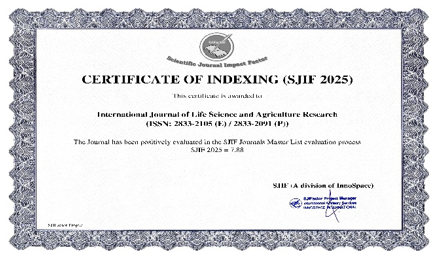Study on Antibacterial and Antioxidant Activity of Extracts from Hydroponic Pennywort Tubers (Centella Asiatica (L.) Urban)
DOI:
https://doi.org/10.55677/ijlsar/V03I6Y2024-09Keywords:
Centella asiatica (L.) Urban, hoạt tính kháng khuẩn, hoạt tính kháng oxy hóa (DPPH)Abstract
Several plant species have been found to contain bioactive compounds that contribute positively to health and are utilized across food, pharmaceutical, and cosmetic industries. The purpose of this research is to investigate the antibacterial and antioxidant activities of extracts derived from hydroponically grown pennywort tubers (Entella asiatica (L.) Urban). The results show that the antioxidant activity of the extract (IC50) was 6.85 mg/mL. The extract demonstrates antibacterial efficacy against foodborne pathogen Escherichiacoli and the pathogenic bacteriumStaphylococcus aureus at the extract concentration of 250 mg/mL. These results underscore the potential of hydroponically cultivated pennywort tubers as a source of bioactive compounds with beneficial applications in the food, pharmaceutical, and cosmetic industries. Further research is warranted to fully explore the hydroponically grown pennywort tubers, aiming to harness their medicinal attributes for disease prevention and human health enhancement in the future.
References
Abdul Rahim, MSA, Baharudin, NA, Ahmad Nazri, IA et al (2021). “ Effect of different drying methods on the antioxidant properties of leaves of Centella asiatica ”, IOP Conf. Series: Earth and Environmental Science, 756: 012054. DOI: 10.1088/1755-1315/756/1/012054 .
Barge, S., Jade, D., Talukdar, NC (2023). "Centella asiatica Linn", Potent Anticancer Medicinal Plants , 1st Edition, Pages19. eBook: ISBN9781003431190.
Chuthaputti, A. (2011) “Asiatic penny wort (Buabok) - herb of the year”, Journal of Traditional Thai and Alternative Medicine, Vol. 9, No. 2, 84-93.
Huang W., Chen L . ( 202 2) . “ Emerging sources and applications of alternative proteins: An introduction ”, Advances in Food and Nutrition Research , 101, 237-275 . DOI: https://doi.org/10.1016/bs.afnr.2022.05.003 .
Jhansi, D., and Kola, M. (2019). “ The antioxidant potential of Centella asiatica”, Journal of Medical Plant Studies, 7(2), 18-20.
Kumar, J. P. and Kavita, T. (2020). "Isolation and Phytochemical analysis of Terpenoids and Asiaticosides from Centella asiatica for their neuroprotective activities", Research Journal of Chemistry and Environment , 24(3).
Mamtha, B, Kavitha, K., Srinivasan, K. K. et al (2004). "An in vitro study of the effect of Centella asiatica [Indian pennywort] on enteric pathogens", Indian Journal of Pharmacology , 36(1): 41.
Mythili, T., and Ravindhran, R. (2012). “ Phytochemical screening and antimicrobial activity of Sesbania sesban (L.) Merr”, Asian Journal of Pharmaceutical and Clinical Research, Vol 5, Issue 4.
Nasution, M.Y., Restuati, M., Pulungan, A.S.S. et al (2018). “ Antimicrobial activities of Centella asiaticaleaf and root extracts on selected pathogenic microorganisms ”, Journal of Medical Sciences , 18(4), 198-204. DOI: 10.3923/jms.2018.198.204 .
Norzaharaini, M., Norshazwani, W. S, Hasmah, A. et al (2011). “ A preliminary study on the antimicrobial activities of asiaticoside and asiatic acid against selected gram positive and gram negative bacteria ”, Health Environ J , 2(1): 23–26 .
Pai S. , Hebbar A. , Selvaraj S . ( 202 2). “ A critical look at challenges and future scopes of bioactive compounds and their incorporations in the food, energy, and pharmaceutical sector ”, Environmental Science Pollution Research International , 29 (24): 35518–35541 . DOI: https://doi.org/10.1007/s11356-022-19423-4 .
Pitinidhipat, N. and Yasurin, P. (2012). “ Antibacterial Activity of Chrysanthemum indicum, Centella asiatica and Andrographis paniculata on Bacillus cereus and Listeria monocytogenes under Osmotic Stress . AU JT, 2012; 15(4): 239-245.
Pittella, F., Dutra, R.C., Junior, DD et al (2009). "Antioxidant and Cytotoxic Activities of Centella asiatica (L) Urb", Int. J. Mol. Sci , (10): 3713-3721. DOI: 10.3390/ijms10093713 .
Ploenkutham, R., Sripromma , P., Amornraksa , S. et al (2018). “ Effect of Roasting and Kneading on Antioxidant Activity and Consumer Acceptance towards Asiatic Pennywort Tea ”, MATEC Web Conf , Volume 187 . DOI: https://doi.org/10.1051/matecconf/201818701004 .
Seevaratnam , V., Banumathi , P., Premalatha , M.R. . et al (2012) . “ Functional properties of Centella asiatica (L.): a review ” , Int. J. Pharm. Pharm. Sci . 4 (5): 8–14.
Sieberi, BM, Omwenga, GI, Wambua, RK et al (2020). "Screening of the Dichloromethane: Methanolic Extract of Centella asiatica for Antibacterial Activities against Salmonella typhi, Escherichia coli, Shigella sonnei, Bacillus subtilis, and Staphylococcus aureus ", Scientific World Journal , vol. 2020, Article ID 6378712, 8 pages. DOI: 10.1155/2020/6378712 .
Wawrosch C. and Zotchev S. B. (2021). “ Production of bioactive plant secondary metabolites through in vitro technologies—status and outlook ”, Applied Microbiology and Biotechnology , 105 (18): 6649–6668. Doi: 10.1007/s00253-021-11539-w.
Wiciński, M., Fajkiel-Madajczyk, A, Kurant, Z., et al (2024). "Can Asiatic Acid from Centella asiatica be a Potential Remedy in Cancer Therapy? - A Review", Cancers, 16(7), 1317. DOI: https://doi.org/10.3390/cancers16071317 .
Ye, M., Ren, L., Wu, Y. et al (2013). “Quality characteristics and antioxidant activity of hickory black soybean yogurt”, LWT-Food Science and Technology, (51): 314-318. DOI: https://doi.org/10.1016/j.lwt.2012.09.027 .
Downloads
Published
Issue
Section
License
Copyright (c) 2024 International Journal of Life Science and Agriculture Research

This work is licensed under a Creative Commons Attribution 4.0 International License.












